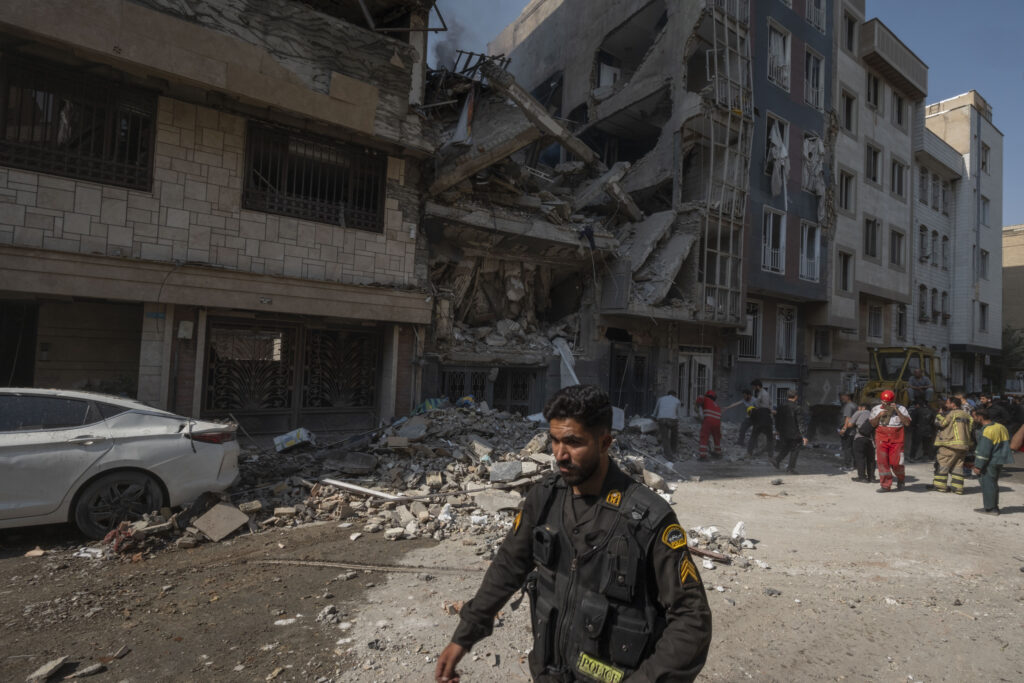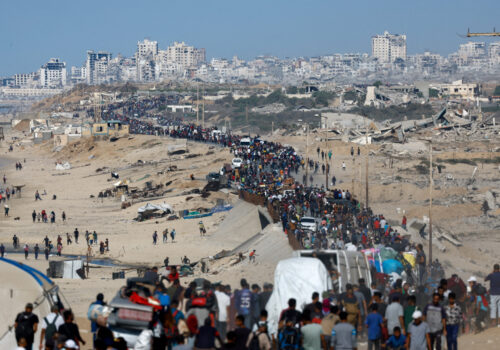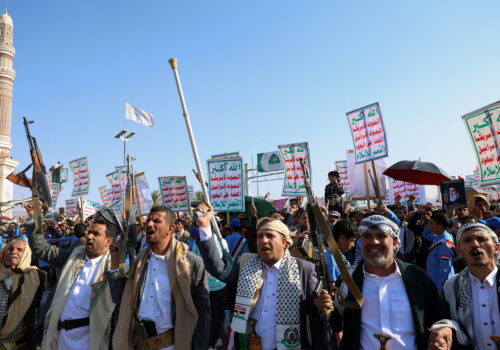Will the US achieve a ‘big, beautiful’ Iran deal or stall in homeostasis?
The brief Twelve Day War between Israel (backed by the United States) and Iran in June—and the recent cease-fire between Israel and Hamas—has led to new questions about whether a deal may now be possible with Tehran, given its increasing isolation on the world stage.
The Gaza cease-fire showcases how, when US President Donald Trump gets personally involved and deploys the full weight of US leverage and creative negotiating tactics, the seemingly impossible can become possible. Israelis, Palestinians, the United States, and the region still have much work ahead to ensure the conflict does not reignite. Trump and his team could try to build on momentum from the Gaza cease-fire to focus on a broader regional deal—that includes addressing Iran, as Trump mentioned in his Knesset speech this month.
There are two broad paths. One, a negotiated deal that could bring long-term resolution. Or two, a fragile cease-fire that is periodically interrupted by conflict. There are risks and opportunities in each scenario.
Scenario one: A ‘big, beautiful’ deal
A “big, beautiful deal” would likely require the United States to offer Iran a pathway to both sanctions relief and integration into regional economic development opportunities, as well as protection from another Israeli attack. While there are ample roadblocks to this scenario, it would yield significant benefits to all parties, not to mention a likely Nobel Peace Prize for Trump. As former US National Security Advisor (and Atlantic Council International Advisory Board Member) Stephen Hadley and Iran expert Vali Nasr discussed at this year’s Aspen Security Forum, such a deal could potentially influence the debate within Iran about how to proceed, given its newly exposed vulnerabilities, and the supreme leader might agree to these terms.
In exchange, Iran would almost certainly need to commit to a much lower level of enrichment (3.6 percent for civilian use, rather than the 60 percent it was enriching prior to the June strikes) and submit to an extremely intrusive International Atomic Energy Agency inspections regime. Iran is unlikely to suspend its domestic enrichment, but one possible face-saving approach could be a joint venture outside the country with investment from Gulf Arab countries. Enriched material could be brought back from the enrichment site—one could be established in Oman, for example—for nuclear power. Iran floated a version of this idea prior to the June war but wanted this joint venture located inside the country.
As part of the deal, Iran might be required to limit its ballistic missile program and support for its regional proxies such as Hezbollah, the Houthis, Hamas, and Iraqi militias. Both of these issues are major sticking points, and neither was addressed in the 2015 Joint Comprehensive Plan of Action. Trump cited these issues as part of his reasoning for withdrawing from the deal during his first term in 2018.
SIGN UP FOR THIS WEEK IN THE MIDEAST NEWSLETTER
For this scenario to come to fruition, Tehran would have to see the deal on offer as distinctly better than the alternatives. After all, the regime has poured billions into its nuclear program and sees it as both a major deterrent for external attacks and a source of national pride. The June war ignited a new wave of nationalism in Iran, which the regime is seeking to use to its benefit. With Hezbollah and Hamas degraded, its partner in Syria gone, and its military weakened, the nuclear program remains Iran’s key negotiating card. The regime is unlikely to end it without terms it can claim as a win, and any Iranian negotiator will face severe pressure from hardliners and the Islamic Revolutionary Guard Corps (IRGC) to maintain key military capabilities seen as existential to the regime.
The United States would need to regain trust with Tehran, provide a painstaking focus on these negotiations, and deliver on two other key elements: one, assurances that it will not leave the agreement—unless certain triggers occur—and two, a formulation to prevent further Israeli attacks on Iran, perhaps in exchange for Iranian commitments to not build a covert nuclear weapons program and to stop arming regional proxies. To get Israel on board, the United States would likely have to apply measured pressure and incentives such as sweetened defense deals and a US-brokered cease-fire with the Houthis to end all attacks on Israel and Israel-linked ships.
This scenario will be tough to achieve because of the complex issues that need to be addressed and the persistence of stubborn sticking points from all parties. Israel would be skeptical of the negotiations and could take military action again at any time, which could upend the talks. If the cease-fire in Gaza holds, Israel may also rebalance security priorities to address its remaining regional security concerns, including Iran.
Scenario two: The intermission—a toxic homeostasis
In a second scenario, an intermission with a toxic homeostasis, US national security concerns relating to Iran’s nuclear program remain unresolved, and the threat of renewed military conflict between Israel and Iran persists. Negotiations may or may not occur, but either way, no real progress is made to address the potential threat of a nuclear Iran or Iran’s other destabilizing activities in the region, such as arming the Houthis.
Currently, the situation seems to be headed in this scenario. This month, Iran’s foreign minister said the United States and Iran are exchanging messages through mediators and that Iran “will certainly consider” a proposal that is “reasonable, balanced, and fair.” He also stated that Iran will not give up its “right to enrich uranium,” a position the United States will likely reject for now, instead insisting that Iran give up its right to enrich as part of any deal.
There are several risks in this scenario worth our attention.
The risks of homeostasis

Israel is likely to take direct military action again inside Iran in the coming months or years if certain red lines are crossed. Those red lines could include Tehran not allowing International Atomic Energy Agency inspectors adequate access, restarting nuclear enrichment, rearming militia groups in the region, or seeking to weaponize its remaining highly-enriched uranium. The United States could join such efforts. If Iran retaliates, Israel would likely burn through many expensive antimissile weapons that the United States has struggled to produce in the quantities needed in recent years. Israel could face a shortage of Arrow interceptors needed to counter long-range ballistic missiles—this was a concern in the recent war, signaling the potential for a bloodier exchange.
Renewed conflict could stretch the US arsenal of antimissile weapons too thin. This is of particular risk if Washington must defend its own assets, or another security crisis erupts elsewhere in the world. During the brief Israel-Iran war in June, the United States used 25 percent of its THAAD missile interceptors, according to reports in US media.
Sustained or intermittent military operations in Iran could take a toll on Israel’s military, economy, and politics. Israel’s strategy in the past was to fight quick, intense wars to preserve its limited manpower and avoid entanglements that endanger its population and strain resources. Many reservists have served multiple tours in Gaza, which impacts their ability to work in their civilian jobs. According to an April 2025 report, over one hundred thousand Israeli reservists have stopped showing up for duty, and the overall reservist training attendance rate at that time was at 60 percent, down steeply from immediately after the October 7 Hamas attacks that launched the war in Gaza. In sum, Israel is likely to face real economic and social costs if it regularly engages in war with Iran.
A renewed conflict would also bring the possibility of regime change in Iran, and the prolonged uncertainty, chaos, and likely more hardline government that would accompany it. Israel nevertheless might believe regime change in Iran will yield a government more open to negotiations, and it might target key members of the government.
Iran might learn lessons from the Twelve Day War in June and respond more intensely with a wider set of military tools. Leaders in Tehran have already threatened to do this. The Iranian leaders who survived the June war witnessed how effectively their military defenses were neutralized. Iran may prepare to respond more effectively to a similar scenario. Retaliatory war plans could be preapproved to commence after an attack, without the direct command of their service commanders or with a wider set of authorizations. Already, Iran in August established a National Defense Council composed primarily of military and intelligence officials meant to streamline wartime decision making, indicating the country’s leadership does not think the conflict is over. The last time Iran had a National Defense Council in place was during the Iran-Iraq war in the 1980s. Furthermore, Iran’s senior military advisor to the supreme leader stated that “we are not in a cease-fire; we are in a stage of war,” signaling Iran’s preparations for conflict at any moment.
Iran can’t win a conventional war against Israel or the United States, so it will seek to impose costs any way it can to reestablish deterrence. Iran could modify or expand its missile salvos to attempt to avoid defenses, choose less defended targets such as commercial shipping, or attempt asymmetric operations, assassinations, and cyberattacks. In the past, Iran often exercised strategic patience even after an immediate conventional response to a US attack. In retaliation for the US assassination of the IRGC Quds Force Commander General Qassem Soleimani in 2020, Iran launched an immediate retaliatory missile attack against US bases at al-Asad and Irbil and facilitated multiple attacks by militias on the US Embassy in Iraq with rockets. Iran also advanced terrorist plots from 2020 through at least 2024 to target Trump, former Secretary of State Mike Pompeo, and other US officials. If conflict resumes, Tehran may hold Washington partly responsible for its military support to Israel, and Iran or its affiliated militia groups could pursue operations against soft targets, including US companies, facilities, and personnel in the region.
Iran or Israel could miscalculate. There’s also the risk that either party could carry out an attack, intentionally or by accident, that inflames the other side and leads to a new conflict. In April 2024, Israel struck an Iranian consulate in Syria, killing seven Iranian officers, including two generals. Iran saw this as a red line, and it responded by launching its first direct attack on Israel. During Hezbollah and Israel’s direct conflict in 2024, Hezbollah projectiles sometimes hit the wrong target, such as in July 2024, when a soccer field in Israel was hit, killing twelve children. During the June Twelve Day War, an Israeli attack on the notorious Evin Prison was widely condemned by Iranian citizens and international humanitarian organizations for causing eighty fatalities, including staff, inmates, and visitors. Accidents and miscalculations such as these risk a much larger reaction from the other side.
The lack of resolution and the start-stop nature of the conflict could harm US and international business interests in the region. Frequent wars—or worries that another one could occur at any time—could impact US business deals and tech cooperation with Gulf states, freedom of navigation, and possibly energy prices. The Arab states will be concerned that any new conflict would threaten their own security and interests. As seen in the June conflict when Iran launched missiles at Qatar, Gulf states may become targets if Iran seeks to pressure the United States to lean on Israel to stop the conflict. The Gulf states would also worry about their ability to ship oil if the Strait of Hormuz is threatened, or if their shipping is targeted by Iranian-backed threats, including from Yemen.
Conclusion
A comprehensive deal is the most beneficial outcome for all parties, but it will be difficult to achieve and sustain due to the painstaking focus required, the severe lack of trust, and the maximalist positions from Iran, Israel, and the United States.
If current trends continue, the situation may drift toward a toxic homeostasis, interrupted by periodic eruptions of conflict as each side seeks to enforce its red lines, increasing the potential of intensifying conflict with far-reaching implications.
There is hope though that, instead, Trump and his trusted advisors, especially Special Envoy Steve Witkoff and Jared Kushner, can draw on their business experience and deal-making skills—showcased to the world as they achieved a breakthrough between Israel and Hamas after two years of war—to incentivize compromise and reach a creative, win-win resolution that changes the course of confrontation to a more secure and prosperous future for the region.
Stefanie Hausheer Ali is an Atlantic Council nonresident fellow and a senior director at international affairs consulting firm Rice, Hadley, Gates & Manuel LLC. The information in this article represents the views and opinions of the authors and does not necessarily represent the views or opinions of Rice, Hadley, Gates & Manuel LLC.
Cranston Kline is a Middle East analyst and former US Air Force Officer. He has served in the Department of Defense and Department of State in the Middle East, Europe, and Washington. His analysis does not reflect the official policy or position of the US government.
Further reading
Wed, Oct 15, 2025
Twenty questions (and expert answers) about the next phase of an Israel-Hamas deal
New Atlanticist By
What will follow part one of the cease-fire deal brokered by the Trump administration? Atlantic Council experts share their answers.
Thu, Oct 16, 2025
After the Gaza cease-fire, what’s next for the Houthis?
MENASource By Osamah Al Rawhani
Will the Houthis cease their regional hostilities? The brief response is yes—but likely, only for the time being.
Fri, Oct 10, 2025
Why Lebanon is stuck in the middle on Hezbollah disarmament
MENASource By Nicholas Blanford
Lebanon finds itself caught between the rock of US pressure for Hezbollah’s disarmament and the hard place of Hezbollah refusing to do so.
Image: U.S. President Donald Trump and his national security team meet in the Situation Room at the White House, in Washington, D.C., U.S., June 21, 2025. The White House/Daniel Torok/Handout via REUTERS THIS IMAGE HAS BEEN SUPPLIED BY A THIRD PARTY



